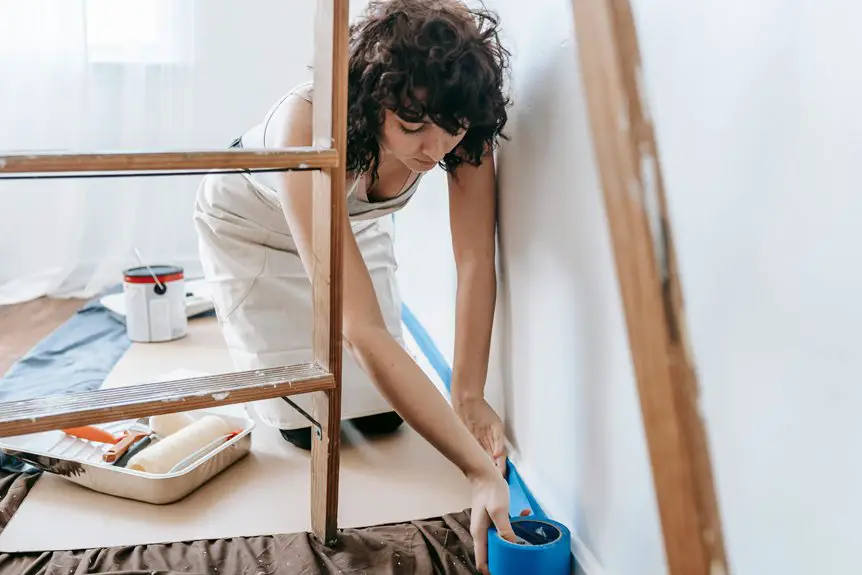To fix flaking and peeling faux leather, start by gently cleaning the surface to remove dirt and oils. Lightly sand any peeling spots, then apply a repair compound in thin layers, letting each dry properly. Seal the area for protection and restore its appearance. Keep in mind, regular cleaning and avoiding heat will prevent further damage. If you want to extend your faux leather’s life and avoid costly replacements, stick around for expert tips and maintenance advice.
Table of Contents
Key Takeaways
- Clean and dry the faux leather surface thoroughly before repair to ensure proper adhesion of repair compounds.
- Lightly sand peeling areas with fine-grit sandpaper to smooth the surface and prepare for filler application.
- Apply repair compound in thin layers, allowing each to dry completely, to fill cracks and peeling spots effectively.
- Seal the repaired area to restore appearance and protect against further damage.
- Maintain faux leather by gentle cleaning, conditioning every three months, and avoiding direct sunlight and heat exposure.
Understanding the Causes of Faux Leather Damage
Although faux leather looks sturdy, it’s prone to damage if you don’t handle it properly. You’ll notice flaking and peeling mainly because faux leather is made from a plastic coating over fabric.
Faux leather may appear durable, but improper care leads to flaking and peeling due to its plastic-coated fabric base.
Over time, exposure to sunlight, heat, and moisture breaks down this coating. When you leave faux leather in direct sunlight or near heat sources, it dries out and loses flexibility, causing cracks.
Using harsh cleaners or scrubbing too hard can also strip away the protective layer. Additionally, constant friction or bending stresses the material, leading to wear and tear.
Understanding these causes helps you prevent further damage and makes repairs more effective. By treating faux leather gently and protecting it from extreme conditions, you’ll extend its lifespan and keep it looking better longer.
Gathering Materials and Tools for Repair
Before you start fixing flaking faux leather, you’ll need to gather the right materials and tools to secure a smooth repair process. Having everything at hand prevents interruptions and guarantees quality results.
Here’s a quick checklist of essentials:
| Material/Tool | Purpose |
|---|---|
| Faux leather repair kit | Contains adhesive and filler |
| Fine sandpaper | Smooths rough edges |
| Soft cloth | Cleans the surface |
Depending on your repair’s extent, you might also want fabric glue, paint for touch-ups, or a small brush. Make certain your workspace is clean and well-lit before you begin. Gathering all necessary items upfront saves time and frustration later.
Preparing the Faux Leather Surface
Before you start fixing your faux leather, you’ll want to clean the surface thoroughly to remove dirt and oils.
Take a close look for any cracks, peeling, or weak spots that need special attention.
Proper preparation guarantees your repair will last and look smooth.
Cleaning Techniques
Properly cleaning your faux leather surface sets the foundation for any repair work and helps prevent further damage. Start by removing dust and loose particles with a soft cloth. Next, use a mild soap solution or a specially formulated faux leather cleaner to gently wipe down the surface. Avoid harsh chemicals that can cause more flaking.
Here’s a quick guide to effective cleaning:
| Step | Tip |
|---|---|
| Dust Removal | Use a dry microfiber cloth |
| Cleaning Solution | Mix mild soap with warm water |
| Wiping | Use a damp cloth, not soaked |
After cleaning, let the surface air dry completely before proceeding with repairs. This guarantees the cleaner doesn’t interfere with adhesion or finish restoration.
Surface Inspection
Start by closely examining the faux leather surface for any cracks, peeling, or areas where the material feels weak. This step is essential because it helps you identify exactly where repairs are needed and prevents further damage.
Run your fingers gently over the surface to detect rough patches or loose flakes. Use a bright light to highlight imperfections you might miss otherwise. Document these problem spots so you can focus your efforts efficiently.
- Feel the frustration melt away as you spot the issues early
- Imagine the satisfaction of restoring your item to its former glory
- Picture the confidence boost from a flawless finish
- Experience pride in saving your favorite piece from ruin
Thorough inspection sets the foundation for successful faux leather repair.
Step-by-Step Repair Techniques
Now that your faux leather is prepped, you’ll start by thoroughly cleaning the surface to guarantee proper adhesion.
Next, you’ll apply the repair compound carefully to fill in any flakes or cracks.
Finally, you’ll finish by sealing the area to protect your work and restore the look.
Cleaning and Preparing Surface
Before you apply any repair products, you’ll need to clean and prepare the faux leather surface thoroughly. This step guarantees the repair material adheres properly and lasts longer.
Start by gently wiping away dust and dirt using a soft cloth dampened with mild soap and water. Avoid harsh chemicals that can damage the material further. Once clean, let it dry completely.
Next, lightly sand the peeling areas with fine-grit sandpaper to smooth rough edges and create a better bonding surface.
Remember, preparation is key to a flawless fix. Take your time so your faux leather can look its best again.
Focus on:
- Removing all debris that weakens adhesion
- Smoothing rough patches carefully
- Letting the surface dry fully
- Avoiding harsh cleaners that cause more damage
Applying Repair Compound
With the surface clean and smooth, you’re ready to apply the repair compound that will restore your faux leather’s appearance.
Start by squeezing a small amount of compound onto a palette or clean surface. Use a flexible spatula or a plastic card to spread it evenly over the damaged area, filling cracks and peeling spots completely.
Apply thin layers, building up gradually to avoid lumps. Smooth the edges so the repair blends seamlessly with the surrounding material. Allow each layer to dry as directed by the product instructions before adding another.
Avoid rushing this step—proper application guarantees durability and a natural finish.
Once you’ve covered all damaged areas, leave the compound to cure fully before moving on to finishing touches.
Finishing and Sealing Steps
Once the repair compound has fully dried, you’ll want to focus on finishing and sealing the surface to guarantee your faux leather looks seamless and lasts longer.
Start by gently sanding the repaired area with fine-grit sandpaper to smooth out any unevenness.
Next, apply a matching leather paint or dye to blend the patch perfectly with the rest of the material.
After the color dries, seal the area using a flexible, clear leather sealer to protect your work.
Remember, these last steps are essential—they not only restore appearance but also add durability.
- Feel proud seeing your faux leather look like new again
- Enjoy the confidence of a long-lasting, flawless repair
- Avoid frustration from quick wear and tear after fixing
- Relish the satisfaction of saving money and resources
Tips for Maintaining and Protecting Faux Leather
Although faux leather is durable, it still needs regular care to stay looking its best. You should clean it gently with a damp cloth and mild soap, avoiding harsh chemicals. Keep it away from direct sunlight and heat sources to prevent cracking. Conditioning your faux leather occasionally helps maintain flexibility and prevents peeling.
Here’s a simple care guide:
| Care Action | Frequency |
|---|---|
| Wipe down | Weekly |
| Condition | Every 3 months |
| Avoid heat exposure | Always |
When to Consider Professional Restoration
If your faux leather shows deep cracks, extensive peeling, or stubborn stains that home remedies can’t fix, it’s time to contemplate professional restoration.
Professionals have the skills and tools to breathe new life into your prized pieces, saving you from costly replacements.
Experts possess the expertise and equipment to revitalize your cherished items, preventing expensive replacements.
You should consider expert help when:
- You feel overwhelmed by DIY attempts that fail to restore your item’s appearance.
- The damage affects sentimental or expensive furniture, making you hesitant to risk further harm.
- You want a durable, long-lasting solution rather than a quick fix.
- You notice underlying issues like fabric damage or mold that need specialized treatment.
Trusting professionals guarantees your faux leather regains both its look and strength, preserving your investment and peace of mind.
Frequently Asked Questions
Can Faux Leather Be Recycled After It Peels?
You can’t easily recycle faux leather after it peels because it’s made from mixed materials. Instead, consider repurposing or donating it if possible. Proper disposal helps reduce environmental impact since recycling options are limited.
Is Faux Leather More Environmentally Friendly Than Real Leather?
Imagine choosing between a plastic tree and a real one; faux leather spares animals but often hides chemicals. You’ll find it’s kinder in some ways, yet not always greener, so weigh both worlds carefully.
What Are the Health Risks of Using Repair Chemicals?
You should know repair chemicals can irritate your skin, eyes, and lungs. They often contain solvents and VOCs, which might cause headaches or dizziness. Always use gloves, work in a ventilated area, and follow safety instructions carefully.
How Long Does Faux Leather Typically Last Before Peeling?
You can expect faux leather to last around 3 to 5 years before peeling, depending on usage and care. Avoid harsh conditions and clean it gently to extend its lifespan and keep it looking good longer.
Are There Faux Leather Types That Don’T Peel at All?
Sure, some sturdy synthetic styles sidestep peeling. You’ll find high-quality polyurethane or microfibre faux leather resists wear better, keeping surfaces smooth and sleek without shedding. Choosing wisely helps you avoid annoying abrasions altogether.
- How to Use Sterile Nonwoven Sponges for Medical Applications - July 11, 2025
- How to Make Nonwoven Polypropylene Non-Absorbent - July 11, 2025
- The Manufacturing Process of Nonwoven Polypropylene - July 11, 2025







